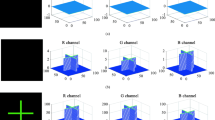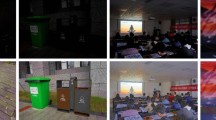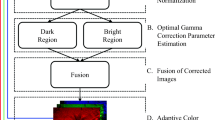Abstract
When taking images in low light conditions, images often suffer from low visibility. In addition to affecting the sensory quality of images, this poor quality may also significantly limit the performance of various computer vision systems. Many grey-level mapping enhancement algorithms based on classic mapping functions, such as the gamma mapping function, have been proposed in recent years to improve the visual quality of low-light images. However, the classic mapping function cannot coordinate the greyscale distribution of the bright and dark areas of the image well and may easily lead to excessive enhancement. This makes it difficult for the performance of these improved algorithms to be fully utilized. Therefore, this paper proposes a new multiparameter grey mapping method. Unlike the classic mapping function, the new mapping method is based on the enhancement strategy of compressing the bright area and then adjusting the dark area. Thus, the inherent shortcomings of the classic mapping function are fundamentally overcome. The new mapping method can not only directly control the compression of the grey space in the bright area of the image through parameters, but it can also adjust the greyscale distribution of dark areas without changing the greyscale value of the pixels in the bright area. Finally, this paper also designs an adaptive enhancement algorithm with the new mapping method as the core to verify its effectiveness and flexibility. Experimental results showed that the adaptive algorithm had excellent performance in colour rendering, brightness enhancement and noise suppression. It was also obviously better than the current similar algorithms in visual quality and quantitative tests.






















Similar content being viewed by others
References
Aditya KP, Reddy VK, Ramasangu H (2014) Enhancement technique for improving the reliability of disparity map under low light condition. In: Patel V, Joshi a (eds) 2nd international conference on innovations in automation and mechatronics engineering, Iciame 2014, vol 14. Procedia technology. Pp 236-243. https://doi.org/10.1016/j.protcy.2014.08.031
Banik PP, Saha R, Ki-Doo K (2018) Contrast enhancement of low-light image using histogram equalization and illumination adjustment. 2018 international conference on electronics, information, and Communication (ICEIC):4 pp.-4 pp. https://doi.org/10.23919/elinfocom.2018.8330564
Cai B, Xu X, Guo K, Jia K, Hu B, Tao D, IEEE (2017) A Joint Intrinsic-Extrinsic Prior Model for Retinex. In: 2017 Ieee International Conference on Computer Vision. IEEE International Conference on Computer Vision. pp 4020–4029. https://doi.org/10.1109/iccv.2017.431
Chang Y, Jung C, Ke P, Song H, Hwang J (2018) Automatic contrast-limited adaptive histogram equalization with dual gamma correction. Ieee Access 6:11782–11792. https://doi.org/10.1109/access.2018.2797872
Cheng H, Long W, Li Y, Liu H (2020) Two low illuminance image enhancement algorithms based on grey level mapping. Multimed Tools Appl 80:7205–7228. https://doi.org/10.1007/s11042-020-09919-x
Dai Q, Pu Y-F, Rahman Z, Aamir M (2019) Fractional-order fusion model for low-light image enhancement. Symmetry-Basel 11(4). https://doi.org/10.3390/sym11040574
Dalejones R, Tjahjadi T (1993) A study and modification of the local histogram equalization algorithm. Pattern Recogn 26(9):1373–1381. https://doi.org/10.1016/0031-3203(93)90143-k
Guo X, Li Y, Ling H (2017) LIME: low-light image enhancement via illumination map estimation. IEEE Trans Image Process 26(2):982–993. https://doi.org/10.1109/tip.2016.2639450
Hao S, Han X, Guo Y, Xu X, Wang M (2020) Low-light image enhancement with semi-decoupled decomposition. Ieee Transactions on Multimedia 22(12):3025–3038. https://doi.org/10.1109/tmm.2020.2969790
Khan MF, Khan E, Abbasi ZA (2014) Segment dependent dynamic multi-histogram equalization for image contrast enhancement. Digital Signal Processing 25:198–223. https://doi.org/10.1016/j.dsp.2013.10.015
Ko S, Yu S, Kang W, Park C, Lee S, Paik J (2017) Artifact-free low-light video enhancement using temporal similarity and guide map. IEEE Trans Ind Electron 64(8):6392–6401. https://doi.org/10.1109/tie.2017.2682034
Land EH, McCann JJ (1971) Lightness and Retinex Theory. J Opt Soc Am 61(1):1. https://doi.org/10.1364/josa.61.000001
Lee H-G, Yang S, Sim J-Y (2015) Color preserving contrast enhancement for low light level images based on retinex. Asia-Pacific Signal and Information Processing Association Annual Summit and Conference (APSIPA), pp 884–887. https://doi.org/10.1109/APSIPA.2015.7415397
Li WS, Hu X, Du J, Xiao B (2017) Adaptive remote-sensing image fusion based on dynamic gradient sparse and average gradient difference. Int J Remote Sens 38(23):7316–7332. https://doi.org/10.1080/01431161.2017.1371863
Li M, Liu J, Yang W, Sun X, Guo Z (2018) Structure-revealing low-light image enhancement via robust Retinex model. IEEE Trans Image Process 27(6):2828–2841. https://doi.org/10.1109/tip.2018.2810539
Liu H, Sun X, Han H, Cao W (2016) Low-light video image enhancement based on multiscale retinex-like algorithm. In: 28th Chinese Control and Decision Conference. Chinese Control and Decision Conference (CCDC), pp 3712–3715. https://doi.org/10.1109/CCDC.2016.7531629
Liu S, Long W, He L, Li Y, Ding W (2021) Retinex-based fast algorithm for low-light image enhancement. Entropy 23(6). https://doi.org/10.3390/e23060746
Lore KG, Akintayo A, Sarkar S (2017) LLNet: a deep autoencoder approach to natural low-light image enhancement. Pattern Recogn 61:650–662. https://doi.org/10.1016/j.patcog.2016.06.008
Mittal A, Moorthy AK, Bovik AC (2012) No-reference image quality assessment in the spatial domain. IEEE Trans Image Process 21(12):4695–4708. https://doi.org/10.1109/tip.2012.2214050
Mittal A, Soundararajan R, Bovik AC (2013) Making a "completely blind" image quality analyzer. Ieee Signal Processing Letters 20(3):209–212. https://doi.org/10.1109/lsp.2012.2227726
Panetta K, Agaian S, Zhou Y, Wharton EJ (2011) Parameterized logarithmic framework for image enhancement. Ieee Transactions on Systems Man and Cybernetics Part B-Cybernetics 41(2):460–473. https://doi.org/10.1109/tsmcb.2010.2058847
Pisano ED, Zong SQ, Hemminger BM, DeLuca M, Johnston RE, Muller K, Braeuning MP, Pizer SM (1998) Contrast limited adaptive histogram equalization image processing to improve the detection of simulated spiculations in dense mammograms. J Digit Imaging 11(4):193–200. https://doi.org/10.1007/bf03178082
Ren X, Li M, Cheng W-H, Liu J (2018) Joint enhancement and denoising method via sequential decomposition. IEEE International Symposium on Circuits and Systems (ISCAS), pp 1–5. https://doi.org/10.1109/ISCAS.2018.8351427
Ren Y, Ying Z, Li TH, Li G (2019) LECARM: low-light image enhancement using the camera response model. Ieee Transactions on Circuits and Systems for Video Technology 29(4):968–981. https://doi.org/10.1109/tcsvt.2018.2828141
Sandoub G, Atta R, Ali HA, Abdel-Kader RF (2021) A low-light image enhancement method based on bright channel prior and maximum colour channel. IET Image Process 15(8):1759–1772. https://doi.org/10.1049/ipr2.12148
Shannon CE (1948) A mathematical theory of COMMUNICATION. Bell System Technical Journal 27(4):623–656. https://doi.org/10.1002/j.1538-7305.1948.tb00917.x
Singh N, Bhandari AK (2020) Image contrast enhancement with brightness preservation using an optimal gamma and logarithmic approach. IET Image Process 14(4):794–805. https://doi.org/10.1049/iet-ipr.2019.0921
Singh K, Kapoor R, Sinha SK (2015) Enhancement of low exposure images via recursive histogram equalization algorithms. Optik 126(20):2619–2625. https://doi.org/10.1016/j.ijleo.2015.06.060
Srinivas K, Bhandari AK (2020) Low light image enhancement with adaptive sigmoid transfer function. IET Image Process 14(4):668–678. https://doi.org/10.1049/iet-ipr.2019.0781
Tan SF, Isa NAM (2019) Exposure based multi-histogram equalization contrast enhancement for non-uniform illumination images. Ieee Access 7:70842–70861. https://doi.org/10.1109/access.2019.2918557
Venkatanath N, Praneeth D, Bh MC, Channappayya SS, Medasani SS (2015) Blind image quality evaluation using perception based features. 2015 twenty-first National Conference on communications. https://doi.org/10.1109/ncc.2015.7084843
Wang Q, Ward RK (2007) Fast image/video contrast enhancement based on weighted thresholded histogram equalization. IEEE Trans Consum Electron 53(2):757–764. https://doi.org/10.1109/tce.2007.381756
Wang Y, Chen Q, Zhang BM (1999) Image enhancement based on equal area dualistic sub-image histogram equalization method. IEEE Trans Consum Electron 45(1):68–75. https://doi.org/10.1109/30.754419
Wang W, Yuan X, Wu X, Liu Y (2017) Fast image Dehazing method based on linear transformation. Ieee Transactions on Multimedia 19(6):1142–1155. https://doi.org/10.1109/tmm.2017.2652069
Wang Y-F, Liu H-M, Fu Z-W (2019) Low-light image enhancement via the absorption light scattering model. IEEE Trans Image Process 28(11):5679–5690. https://doi.org/10.1109/tip.2019.2922106
Wang W, Wu X, Yuan X, Gao Z (2020) An experiment-based review of low-light image enhancement methods. Ieee Access 8:87884–87917. https://doi.org/10.1109/access.2020.2992749
Yang J, Jiang X, Pan C, Liu C-L (2016) Enhancement of low light level images with coupled dictionary learning. In: 23rd International Conference on Pattern Recognition (ICPR), pp 751–756. https://doi.org/10.1109/ICPR.2016.7899725
Yang K-F, Zhang X-S, Li Y-J (2020) A biological vision inspired framework for image enhancement in poor visibility conditions. IEEE Trans Image Process 29:1493–1506. https://doi.org/10.1109/tip.2019.2938310
Yang W, Wang S, Fang Y, Wang Y, Liu J, IEEE (2020) From Fidelity to Perceptual Quality: A Semi-Supervised Approach for Low-Light Image Enhancement. In: 2020. IEEE Conf Comput Vis Pattern Recognit:3060–3069. https://doi.org/10.1109/cvpr42600.2020.00313
Yanqin Z, Xihui F, Zhenchong W, Guoliang F (2011) A new image enhancement algorithm for low illumination environment. 2011 IEEE international conference on computer science and automation engineering. https://doi.org/10.1109/csae.2011.5953297
Yu C-Y, Ouyang Y-C, Wang C-M, Chang C-I (2010) Adaptive inverse hyperbolic tangent algorithm for dynamic contrast adjustment in displaying scenes. Eurasip Journal on Advances in Signal Processing 2010. https://doi.org/10.1155/2010/485151
Acknowledgments
This work was supported by Science and Technology Department of Sichuan Province, People’s Republic of China (No. 2020JDRC0026).
Author information
Authors and Affiliations
Corresponding author
Ethics declarations
Conflict of interest
We declare that we do not have any commercial or associative interest that represents a conflict of interest in connection with the manuscript entitled “A New Grey Mapping Function and Its Adaptive Algorithm for Low-light Image Enhancement”.
Additional information
Publisher’s note
Springer Nature remains neutral with regard to jurisdictional claims in published maps and institutional affiliations.
Rights and permissions
Springer Nature or its licensor holds exclusive rights to this article under a publishing agreement with the author(s) or other rightsholder(s); author self-archiving of the accepted manuscript version of this article is solely governed by the terms of such publishing agreement and applicable law.
About this article
Cite this article
He, L., Long, W., Liu, S. et al. A new grey mapping function and its adaptive algorithm for low-light image enhancement. Multimed Tools Appl 82, 6071–6096 (2023). https://doi.org/10.1007/s11042-022-13598-1
Received:
Revised:
Accepted:
Published:
Issue Date:
DOI: https://doi.org/10.1007/s11042-022-13598-1




